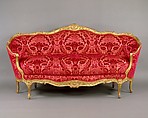Sofa (ottomane veilleuse)
Jean-Baptiste I Tilliard French
Possibly by Jean-Baptiste II Tilliard French
Jean-Baptiste l Tilliard belonged to one of the most important families of menusiers (joiners or chairmakers) active in Paris. He worked from about 1730 for the Garde-Meuble (the organisation of the French royal household responsible for all the furniture, art, and other movable objects in the royal palaces) as a menuisier-ordinaire. As such he supplied chairs, tables, and consoles for the crown, the prince de Soubise and other important patrons. Tilliard was influential in bringing the Louis XV style in chairs and other carved furniture into fashion.
Jean-Baptiste ll Tilliard became a maitre (master) in 1752 and worked with his father in a shop on the rue de Cléry until 1764, when the elder Tilliard retired. As both father and son used the stamp TILLIARD, it is sometimes difficult to distinguish their work from one another. The graceful curvilinear yet somewhat restrained outline of this sofa would indicate a date of 1750–1760, suggesting it is most likely the work of the elder since the younger Tilliard worked mostly in the Louis XVI style.
Characteristic for both craftsmen is the use of a heart-shaped cartouche as a decorative motif either in the center of the front seat rail or the top rail of the back, sometimes in both places. The same motif appears also at the top of the front legs and twice more on the top rail.
The carving of the cartouche, the rococo scrolls, and the flowering vines is closely related to that on a daybed stamped by Tilliard, now in the Victoria and Albert Museum, London.
Due to rights restrictions, this image cannot be enlarged, viewed at full screen, or downloaded.

